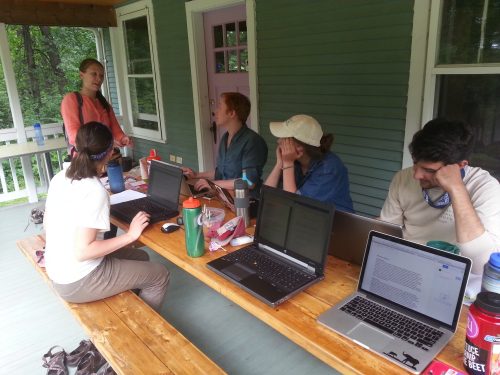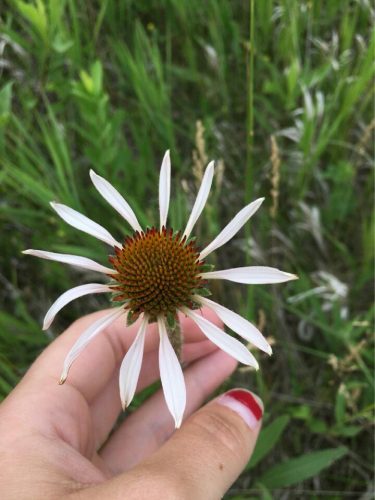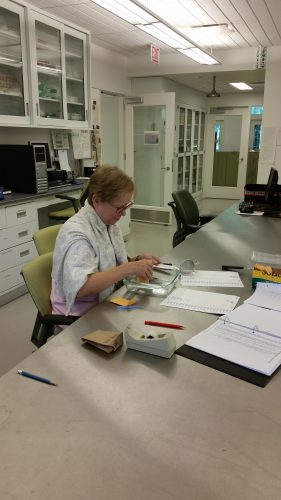|
|
Hello, dark fringes of the web,
Sunday began literally with a bang, as we had thunderstorms all throughout the night. Most of us slept pretty well, I think. Still, there were definitely some thunderclaps right over us in Kensington. Despite this, Alex, Amy, Laura and Leah woke up early in the morning to do some field work for independent projects. Leah, Amy and Alex visited some of our Northwest sites to catch pollinators. Unfortunately, the cool weather and wet conditions meant that there were a whopping zero pollinators to be caught for Leah’s project. However, she did get this pretty hilarious picture of a Melissodes (long horned bee) on a stick.
 Straight muggin with a bee on a stick. Amy had better luck, and did style persistence well into the afternoon, despite some scary looking clouds and losing a coveted sharpie.
The rest of us had more relaxed days. Lea made soup with some of our left over vegetables. James recovered from a mystery illness. Laura and I found a large beetle on the porch of Town Hall, which excreted a mystery liquid from its back when poked. It was really funny, but only because I wasn’t the one who touched the beetle. Many of us put finishing touches on our independent project proposals, and we began editing (ahem, peer reviewing) each others’. We finally followed through on our longstanding plans to have brinner ( = breakfast dinner). Amy, Lea, Laura and I made hash (no, not that hash) with onions and spotty yellow kale, an egg scramble with onions, kohlrabi greens, and Napa cabbage, and pancakes with mystery ingredients. Somehow, we still have lots of onions left — if only we put them in the pancakes! Over dinner, we talked about how to survive a tornado (hint: hide in the bathroom), among other things, and tried to convince James that he was having a fever dream. Tomorrow is back to the field for phenology and whatever else the weather allows.
 “Fever dreams” by Laura
 Leah just wishes that bees would land on a flower and not on her camera Laura and Leah had already started their day much earlier than the rest of us to wipe the pollinators that they caught yesterday in p2 on flowers in p1 for Laura’s independent project. When the rest of the team arrived at the Hjelm House, pollinators were out and about, so most of the team went out for pollinator observations. Other members of the team worked on assessing compatibility and used the GPS. From what I gathered from stories at lunch and messages in a certain group chat, the team saw some pretty interesting things, including a mysterious rodent. After observations, team members did some weeding, resulting in an assessment of a large thistle that might be taller than Abby.
 Here’s just one pile of buckthorn that was cut from a plot!
Meanwhile, I went to the bog to remove buckthorn. Since we had removed all of the buckthorn from four of my plots yesterday (HUGE thanks to Jennifer, Laura, and Leah), I only needed to remove it from one more plot. And I did it! Buckthorn was cut and herbicide was applied to the stumps so that it won’t grow back (*crosses fingers).
 Abby shows us her favorite Snapchat filter with this stunning selfie When we convened for lunch, several of us tried out various Snapchat filters and talked about which ones we like best (In case you’re wondering, my favorite is the flower crown or the dog ears). My data loggers arrived so another shout-out is in order, this time for Gretel and Will, who figured out how to put in the batteries. After lunch, we were ready to get back to work.
I went back to the bog to set up my data loggers. These measure micro-climate data like temperature and humidity. Afterwards, I joined James and Lea in p1 to catch any plants that had been missed previously. We found 11 new plants! It started to rain once we finished so we trekked back, finished some chores, and headed home.
Everyone was hungry after such a busy day, so we were excited about the risotto and salad that Lea made. We were also excited to treat ourselves to ice cream for dessert. Unfortunately I broke a spoon, but someone said it must have happened because all of that buckthorn cutting made me really strong.
It’s a busy day here at the Chicago Botanic Garden. Art, Char, Suzie, and Suzanne were all in this morning, counting achenes and cleaning heads. We’re about 75% through Bag 5 out of 12. I’ve continue to dry and freeze seeds from 2014 and stay busy with my common garden experiment out at Rollins Savanna in Grayslake, IL. We were also excited to welcome our new volunteer Ivy, to Team Echinacea!
 Everyone hard at work and enjoying some coffee!
Today we all divided up to complete phenology at all sites but were interrupted by thunder. We all hurried back to the Hjelm house to wait it out. After seeing the closest lightning strike most of us have ever experienced we decided it would be best to wait until 4 to go back out. Some of the taller members of the team were concerned for their safety still & suggested short members go out first because they’re “farther away from a lightning strike”. Ruth visited today to help with phenology and also made tags during our lightning break. During lunch Lea updated us on her independent project. She wants to look at how burn years affect co-flowering species of Echinacea and settled on other composites. Because they aren’t clonal it’s easy to track individual flowers and Lea feels comfortable recognizing when composites are flowering. She’s going to track when composites along a transect in Staffanson begin and end flowering and compare the burned unit to the non-burned unit. Jennifer helped clarify the difference between Andrena and Melissodes to other Lea and me. Although she described their different appearances she told us the biggest difference is their foraging behavior atop Echinacea. Eventually we finished phenology for the day and headed home to eat Amy and Laura’s wild rice soup.
 Female Melissodes Highlights of the day:
Jennifer brought her munchkin, Zachary, to work. It’s never too early to join Team Echinacea.
Ruth brought an amazing rhubarb bundt cake and Amy, Lea and Laura fought over the last piece (James took the second to last all for himself).
Playing “was that thunder or a truck?”
Today team echinacea celebrated independence day with a picnic at the Elk Lake beach, The gathering started with the annual reading of the Declaration of Independence, and remembering why we celebrate on the Fourth of July. After the reading was complete the team had a potluck which included baked beans, lots of fruits and veggies and some really good iced tea! After eating and of course waiting 30 minutes some of the team swam and canoed. All in all a great picnic and the team is looking forward to having the day off tomorrow!
 Stuart starts off the reading of the Declaration!  The Feast!
Today we recorded first flowering dates for the early-flowering Echinacea plants in our remnant populations. For short, we call this activity “phenology.” Now we want to estimate how many total plants will flower this year at each site.
At four remnants (eri, sap, yohe, and lfw), we also recorded as many plants as we could find in bud. The ratio of currently flowering plants (flPla), to all plants in bud (allPla) at these sites ranged from 9 – 27%.
The below table shows the estimates (guesses) of how many plants will flower at each site this summer based on the assumption that 10% (guessHigh) and 25% (guessLow) of plants at each site are already flowering.
> aa[order(aa$guessLow), ]
site proFl allPla flPla guessLow guessHigh
12 nwlf 0.00 2 0 0 0
16 rrxdc 0.00 2 0 0 0
20 tower 0.00 1 0 0 0
23 woody 0.00 1 0 0 0
5 gc 0.50 2 1 4 10
17 sgc 1.00 1 1 4 10
10 lcw 1.00 2 2 8 20
11 nrrx 1.00 2 2 8 20
22 tplot 0.50 4 2 8 20
25 yohw 0.67 3 2 8 20
3 eri 0.09 33 3 12 30
6 kj 1.00 3 3 12 30
15 rrx 0.43 7 3 12 30
21 th 0.75 4 3 12 30
24 yohe 0.22 18 4 16 40
1 aa 0.56 9 5 20 50
19 sap 0.19 26 5 20 50
4 eelr 0.54 13 7 28 70
18 sppe 0.57 14 8 32 80
2 alf 0.50 20 10 40 100
13 on27 0.60 25 15 60 150
8 lfw 0.27 74 20 80 200
7 lfe 0.39 62 24 96 240
14 ri 0.44 54 24 96 240
9 lce 0.74 34 25 100 250
>
These estimates will help us decide which populations to choose for our planned systematic observations of bees this summer.
This week the crew pushed on cleaning and re-checking seeds and counting achenes. I spent a good amount of time prepping seeds to be frozen for long term storage. These seeds are from several different experiments in 2013 and 2014 and have not been X-rayed. They must be placed in the dryer for two weeks, which removes enough internal moisture to avoid the seed rupturing when frozen at -20 degrees Celsius. These E. angustifolia seeds join the Dixon National Tallgrass Prairie Seed Bank here at the Chicago Botanic Garden. This collection has aimed to bank at least one representative sample of every species found in the tallgrass prairie ecosystem. Multiple populations have also been sampled for more than 500 species that are deemed critical to prairie restoration, so our seeds are in good company!
 Seeds from multiple experiments in 2013 going in the dryer.
Today was another great day on Team Echinacea. This morning we continued our work on Q2, and we continued to make significant progress. We measured many plants and found at least five new plants in the experimental site. After a hearty lunch and a short time marveling at ice formations in a water bottle, Amy Dykstra gave a presentation on her research, which included her study of local adaptation of Echinacea. The afternoon was filled with preparations for IS projects (for the Wooster folks) and independent projects for the rest of us. Leah and Laura quickly became adept at catching pollinators, but were not so successful at transferring the collected pollen to fuchsin jelly. The rest of us hunkered down on our computers, read some literature, prepared project proposals and thought about how hard it would be to use NMR and IR to analyze pollen.
 Leah regales us with stories of captured pollinators and attempts at melting fuchsin jelly on a car dashboard. The exciting news of the day is that we found our first flowering Echinacea in P1 and at Elk Lake Road East! Tomorrow we will find out how many more Echinacea are flowering.
 The second flowering Echinacea (found at Elk Lake Road East)!
It’s been steady work back here at the Chicago Botanic Garden. The heads from exPt2 collected in 2015 have begun to be re-checked for any remaining achenes. We’re also about halfway done cleaning the heads from the 4th of 12 bags for exPt2. Overall, this is a BIG job as 1,215 heads were collected last year in this plot, an amount nearly five times the amount of heads seen in 2014. Only time will tell how this year will compare! Everyone in the lab and in the field keep up the great work!

Char, Aldo, and Susie cleaning heads from exPt2.

Leslie making sure the heads are cleaned of all achenes.
This weekend is “Runestone Days” in Kensington. Last night, we got the chance to scope out the scene and talk to a few people in town. This morning, the Lions Club of Kensington gave us way too much food at the Pancake Breakfast. It was so much fun to have time to eat, chat, and be able to learn more about each other. Then, we walked around town, checking out the garage sales. We headed back to Town Hall once it began to rain and spent the rest of the afternoon relaxing.
 Leah, Lea, Laura, Alex, James, and I experiencing the atmosphere at Runestone Days  Alex shows off his new hat and honey that he bought from the garage sale
|
|
















